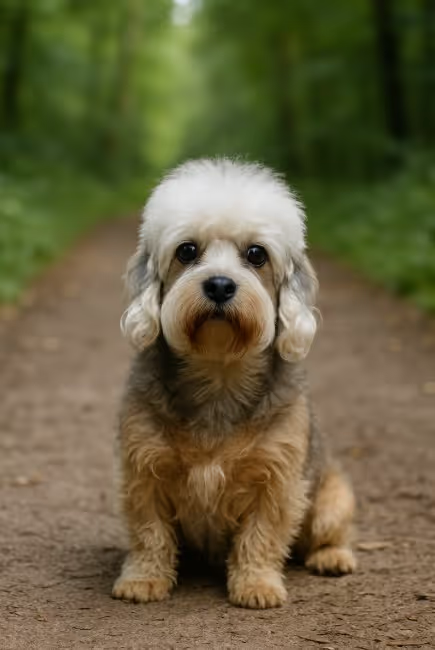The Dandie Dinmont Terrier is a dignified, long-and-low Scottish earthdog—calm in the house, game outdoors, and famously loyal. With a crisp body coat and a silky topknot, Dandies are quieter than many terriers yet remain keen hunters with real prey drive. If you’re asking “Are Dandie Dinmont Terriers good apartment dogs?”—yes, with daily walks and enrichment. “Do Dandies shed?”—low to moderate, lowest when hand-stripped. “Are Dandies hypoallergenic?”—no.

Developed in the Scottish Borders as a fearless farm and vermin terrier, the breed earned its name from “Dandie Dinmont,” a character in Sir Walter Scott’s 1815 novel Guy Mannering. Fanciers standardized the distinctive low, long outline, domed head with silky topknot, and steady, courageous temperament. Today Dandies are rare but cherished companions and sport dogs (earthdog, scent work, rally).
Compact, long-bodied, short-legged terrier with a curved topline and expressive eyes.
Lower shedding when coat is hand-stripped; keep the topknot neat and silky.
Moderate daily outlets; protect the long back from repetitive impact.
Bright, affectionate, and independent—keep sessions upbeat and purposeful.
Keep lean to protect joints and the long back.
Generally sturdy and long-lived, with a few breed-linked risks—screen and manage proactively.
Rarer in Canada—plan early and verify health/temperament transparency.
Are Dandie Dinmont Terriers good apartment dogs?
Yes—adaptable and relatively calm indoors with 45–60 minutes of daily exercise and enrichment.
Do Dandie Dinmont Terriers shed?
Low to moderate. Hand-stripping every 8–12 weeks keeps shedding minimal and the coat harsh.
Are Dandie Dinmont Terriers hypoallergenic?
No breed is truly hypoallergenic; Dandies are lower-shedding with correct grooming.
How much grooming does a Dandie need?
Brush 1–2×/week, hand-strip every 8–12 weeks, and maintain nails/teeth/ears; keep the topknot neat and silky.
How much exercise does a Dandie need?
Plan for 45–60 minutes daily plus brain work (nose games, tricks, training).
Do Dandies bark or dig a lot?
They can—both are terrier traits. Teach “quiet,” provide a dig pit, and add scent games as outlets.
Are Dandies good with kids and other pets?
Generally affectionate with early socialization; supervise play and manage prey drive around small pets.
Dandie vs Cairn/Skye—what’s different?
Dandies are longer/lower with a silky topknot and come only in pepper or mustard; temperament is often calmer indoors than some cousins.
What health tests should breeders do?
CAER eyes + gonioscopy and patellas; discuss family history of IVDD and thyroid.
How do I protect a Dandie’s back?
Keep them lean, use ramps, limit jumping/stairs, and build core strength with controlled exercises.